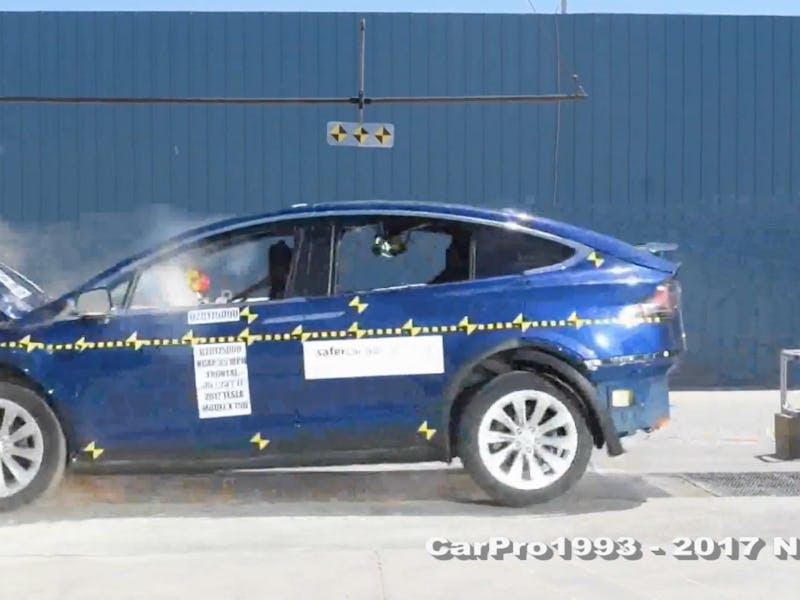On Tuesday, the National Highway Traffic Safety Administration released its safety rating for the Tesla Model X, and buddy, the news is good.
The NHTSA gave Tesla CEO Elon Musk’s massively over-engineered luxury SUV a perfect 5 out of 5 in every category that it tests for, the highest rating it’s ever given to a SUV. As TechCrunch notes, the Model S — Tesla’s luxury sedan — is the only car that’s statistically safer in the NHTSA’s ranking system (based on the overall chance of injury to passengers). But what exactly makes Tesla vehicles so safe? During the Tesla shareholder’s call last week, Musk explained it pretty well.
“For death or serious injury for S or an X you really have to — it’s hard to do that,” Musk said. “The Model S and the X have such a long crumple zone that’s two to three times longer than a conventional automotive car that’s got a big engine steel block in there.”
Frunk
What Musk is talking about is a unique feature of many electric cars. Tesla vehicles have a front trunk, or “frunk,” instead of an engine block in front of the car. That means that in between the driver and whatever they’re hitting is essentially a metal and plastic box that can “crumple” and absorb force, like landing on a big stack of cardboard boxes. Modern cars (gas and electric) have gotten way safer than the all-steel monstrosities of the past, and are specifically designed with crumple zones, but it’s difficult to get around the fact that in a conventional car, there’s a giant heavy steel weight (the engine) that gets slammed back into the steering column and front seating area motors. You can actually see the engine-free crumple zone in action in this NHTSA test video of the Model X (skip to 1:54 for the big crash):
As you can see, the front of the car gets absolutely mashed, but the damage pretty much stops in front of the front axle, instead of pushing a giant engine block back into the passenger parts of the car. As Techcrunch also notes, the battery pack on Tesla vehicles is also distributed along the bottom of the car (which you can see disassembled by some Tesla thieves last month). The battery is heavy, and sticking it on the bottom of the car makes the Model X much less top-heavy and prone to rolling than other SUVs. But the crumple zone is key — Musk pointed out that it actually makes collisions with Teslas safer for the drivers they hit.
“It means you actually are helping even the car that you hit — the combined crumple zone of both cars is substantially longer than if two gasoline cars hit,” Musk said. “The safety’s not just good for people in the car, it actually helps if you do have a collision with another car.”
The funny (and a little morbid) part of this is that the frunk design also makes Tesla cars safer for pedestrians, because they literally bounce off the hood instead of slamming on an engine block (which is maybe why you won’t see them in Death Race).
“Sort of a Trampoline”
“The hood is designed to be, like, a sort of trampoline,” Musk said. “Now it’s not the funnest trampoline, but again there’s no big engine block that you’re going to hit, so if you do hit a pedestrian, it’s not a good time but … the spring effect … makes a big different to the life of a pedestrian if one is hit.”
The crumple zone is also probably what saved this Tesla Model S owner’s life, when he got side-swiped by a massive trailer truck hauling jet engines.
You can see the hood crumpled pretty clearly in these shot:
Yikes.
We can hope that this design spreads to more and more cars as conventional engines become obsolete, as it’s already saving lives. In the mean time, sticking close to a Tesla in heavy traffic probably isn’t a bad idea (but a better idea is like, driving responsibly and not hitting stuff).
